by Wine Owners
Posted on 2018-10-22
Omar Khan’s Business & Wine events are hedonistic epics of wine indulgence and learning, and October 2018’s event at The Four Seasons on Park Lane was no exception.
Bouchard’s 2005s are a stunning set of wines, and when compared with 2015 showed fabulous balance and freshness. A beautiful menu that proved a perfect foil to the great wines served including Chevalier Montrachet La Cabotte 2002 and Beaune Greves La Vigne L’Enfant Jesus 1976 demonstrated how unfair Michelin can be in its treatment of hotel establishments compared with independent restaurants: Romuald Feger deserves a couple of stars!
By the time Henriot bought Bouchard Pere et Fils in 1995, the venerable House, founded in 1731 had found itself in a bit of a financial squeeze. New oak barrels were rationed and the wine maker was making do.
Herriot’s purchase changed all of that, and by 2005 Bouchard was well and truly reestablished as one of the great Burgundy Houses, and a microcosm of Burgundy itself with vineyard holdings representative of practically every commune across the Cote de Beaune and Cote de Nuits. The responsibility of this unique heritage is keenly understood by Henriot: so that for consumers discovering Burgundy, whose initial enthusiasm can so easily be diverted by an underwhelming experience, Bouchard Pere et Fils offer a swathe of benchmark wines.
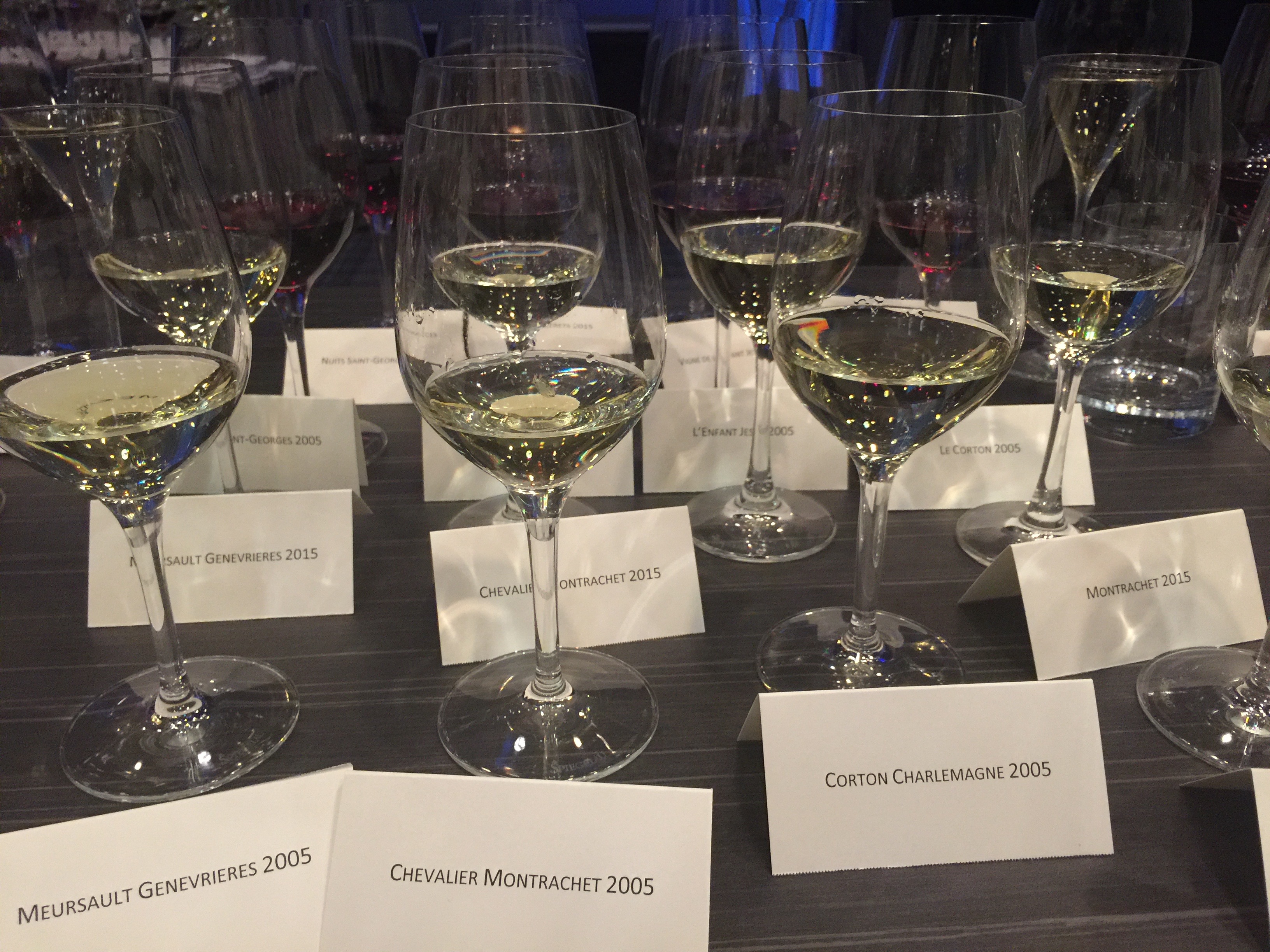
Tasting a cross section of the 2005 Burgundies compared with the 2015 vintage highlighted a number of exceptional terroirs. It also showcased the very high quality of the 2005 vintage. It may well be that 2015 was a much more successful version of 2009, with the warmth of the vintage kept fresh and with retained definition of fruit thanks to more controlled wine making, but on this showing the wines are less precise and less fresh than 2005. Maybe they just need more time; sometimes the intrinsic balance of a wine changes shape over the course of the early years in bottle. Let’s hope that’s the case with these 2015s because the whites in particular need to freshen up.
A little more on the 2005 vintage chez Bouchard. These are, in a word, brilliant. We suspect most Burgundy-philes have resisted broaching their 2005s for fear of encountering a tannic behemoth, such are the tales of untamed structure in the top wines. This range tells a very different story: of freshness; blood orange mid palates, confit fruit illuminated with beaded acidity, and the sort of drive and energy that makes you want to dribble into your poulet de bresse aux tropettes de morts. Of course there’s structure too, but it’s balanced, provides focus and is more than offset by oodles of rich juicy fruit.
Ot the reds L’Enfant Jesus showed the precision of the Beaune Greves vineyard, with a bright thrust of energy, resonance and depth, and a mid palate veined with blood orange and black chocolate. This is a wine for the ages.
Le ‘Le Corton’ is a great red terroir, produced from a vineyard which is also permitted for white Corton. This 2005 doesn’t have the earthy depths of a Bressandes, but exhibits great drive, energy, a concentrated confit mid-plate and is very elegant. A more delicately formed Corton and in my view all the better for it.
Volnay Caillerets 2005 is a more forward wine, although the term is relative in context of the preceding wines. Aromatically spiced with a dark liquorice sweetened mid palate that has a creamy texture, a good sense of energy with oranges present on the finish.
On the night the Chevalier Montrachet 2005 was chalky and mineral, insinuating in its attack before gradually but determinedly building intensity. Very, very long. Le Montrachet 2005 was a powerhouse but so, so primary; a tough one to judge other than elementally and so to try to anticipate something extraordinary in the coming decades.
On this showing, other than recommending you fill your boots with Bouchard 2005s, you might want to check if 2005 Burgundies are well enough represented in your cellar. If not, they’re not going to get any cheaper as they get closed to the start of their drinking windows, so now’s as good a time as any to start looking for some.
by Wine Owners
Posted on 2017-01-30
This report is written on the back of 3 days of tasting cask samples and back vintages chez producers in Burgundy, hot on the heels of the London tastings.
We visited 13 small producers and tasted well over 100 wines in cellars, tasting rooms and producers’ homes, evenly split between the Cote de Nuits and Cote de Beaune.
The London en primeur tastings showed open wines with plenty of fruit. Those that were bursting with energy stood out, with some showing somewhat mute: a little flat or lacking in definition. Such are the challenges of transporting samples directly from barrel and expecting them to perform. Sometimes they do, often they don’t.
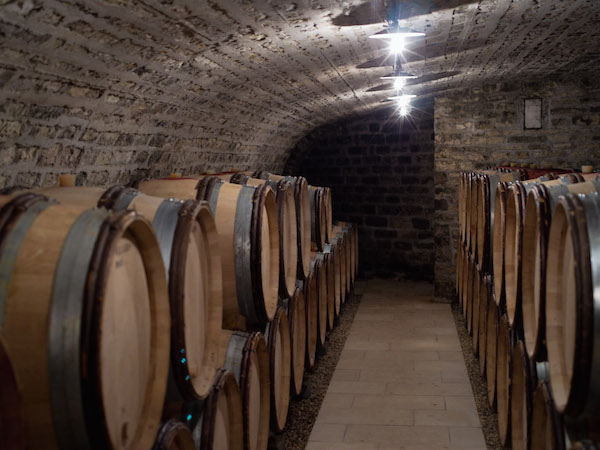
Barrel tastings in situ are a much better opportunity to judge wines individually and form a view on the vintage overall. Unsurprisingly the wines showed much more consistently than they had done in London.
If you can taste alongside prior vintages, as we did on a few occasions, that’s all the better as it provides useful context.
Comparisons have been drawn with previous vintages by commentators, notably 2005 and 2009 (presumably due to the hot summers they all have in common).
The producers don’t agree. 2009s show in a bigger, atypical mould. 2005s are considerably more tannic, built for the very long term, and most will need a good while yet. A few producers see 2005 as the greatest vintage of their generation, but many more look to 1999 as their benchmark.
2015 has the fruit and accessibility of 2012, with more volume and structure, and seemingly similar PHs. It’s an alluring vintage without the generally slacker character of 2009. Most of the successes were picked early, before the rains on 10th September. But some held off and still produced lovely wine. Others who harvested after the 10th have wines that seem to me to be too sweet, perceptibly lower in acidity and have less fine tannins. For the majority that were successful, the watchword was very little or no punching down, almost everyone opting for gentle extractions.
Some producers went for a high proportion of whole bunch fermentation. Those practising the inclusion of whole bunches do so to add an extra sense of freshness and complexity. It’s worth pointing out that stems actually slightly increase the PH, so lowering acidity in the finished wine. But they also contribute different, plant-derived flavours such as eucalyptus and mint, and it’s possibly this that gives the impression of making the wine feel light-footed. Perhaps the marginal lowering of acidity also contributes to a silkier mouth feel. Theoretically whole bunches also add a bit of structure, but I’d guess it depends on what percentage is used and often you don’t sense it.
Having tasted plenty of wines with and without whole bunches, it does seem that a common aspect of the vintage character is the silkiness of the tannins that are present irrespective of these types of winemaking decisions.

Another facet of 2015 is its lovely concentration. Pinot Noir excels in vintages that aren’t bountiful. Yields in 2015 were generally lower than in 2014, 1990 or 1999. This was especially true of the Cote de Beaune because the vines hadn’t fully recovered from the stressing effects of hail in the preceding years.
2015s are fruity, rich, with good density and show definition. On balance I personally preferred cooler sites – due to location, aspect or being in a windy spot. But others will favour out-and-out richness and a broad-shouldered character from the warmer sites. We all have our palate preferences and that’s as it should be. In any case there are no universal rules to successful buying in 2015 since the different vineyard characters shine through.
The greatest relative successes are the lesser appellations. There are some truly superb Bourgogne rouge and village level wines. You’d be seriously missing out if you just focus on trophy wines.
Village wines in 2015 are priced similarly to the levels of Premier Crus from just 2 vintages ago. Grand Crus are up by a third in many cases. If you go long on 2015 now and choose to rationalise in a few years’ time, there are no guarantees that you’ll get your money back.
If you ask which were my favourite communes in 2015 that especially shone, I’d plump for Pommard, Aloxe-Corton, Chambolle-Musigny, Morey-St-Denis and Gevrey-Chambertin.
Nevertheless, I was delighted by lovely wines from Auxey-Duresses, Santenay and Volnay. I thought Nuits-St-Georges and Vosne-Romanée were stunning successes in 2014, and it was no surprise that they showed at least as superbly in 2015.
By now you’ll have formed the impression that 2015 is a great vintage across-the board. Indeed it is. Yet not everyone is happy.
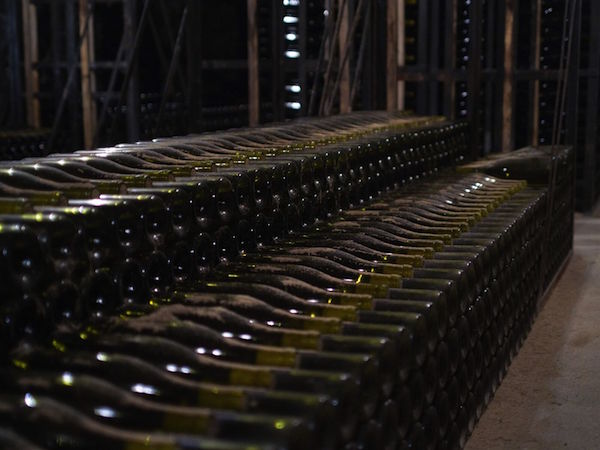
A proportion of long-term collectors are refusing their allocations this year for the first time, which may tell us something about the sustainability of these levels. Some of those ‘given up’ allocations are going to overseas buyers who spend vast annual sums with the big London merchants. But Burgundy producers are well aware of the grey market of en primeur releases originating out of the UK. For now, they are tolerant of it, but for how much longer?
Many merchants are concentrating allocations in the hands of their wealthiest buyers who spend by far the most throughout the rest of the year. And when I say spend, I mean spend. Their dependence on wine investors or wine accumulators makes it harder for them to allocate widely, and correspondingly difficult for Burgundy lovers to gain access to many Grand Crus and Premier Crus. In that fundamental sense the market has changed out of all proportion.
Overall takings at the 2016 annual Hospices auction were down 25% on the previous year (although it’s worth remembering the historic 2015 auction record was in aid of the Paris victims of the IS-inspired atrocities). There is less of 2016 to go around due to the catastrophic late April frosts from the tip to almost the toe of the Cote D’Or, but the quality of what was made is very good and it’s another warm vintage.
If you’re UK based, one other thing to consider is that the Sterling Euro exchange rate will be volatile over the next couple of years, and many will be betting against the Euro during this timeframe. Presidential election results in France in 2017 could have a major impact on the Euro’s relative strength or weakness.
With this in mind, and given the extremely high release prices in the UK for 2015 Burgundy, it’s worth revisiting 2014 for all those who held back.
With a few months or more in bottle, the red wines are showing superbly, with dark, ripe fruit, excellent minerality and sufficient structure to assure medium to longer term drinking.
2014 is a good vintage. It’s a more classic red Burgundy vintage than 2015, majoring on its lovely balance. Based on these tastings, I am delighted to have bought so much of it.
2014 white wines have wonderful intensity, and though enjoyable for their terrific concentration already, are going to age beautifully. I’ll be laying down my best bottles for 15 or more years, but will surely be tempted to dip in regularly along the way.
2013 was plagued by miserable weather. Producers needed to battle the elements, along with mildew and rot. They had to work assiduously all the way through. Perhaps because of this the best producers are proud of their achievements. Reds 'pinottent', that is to say they show fine, overt varietal expression in a really fresh, lifted mid-weight style, with one proviso: just so long as vineyard husbandry was top notch the wines were able to draw energy from the life of the soil and yields were managed to concentrate the berries.
2013 reds may be mid-weight, but the best have a lovely ethereal intensity, and village wines are starting to drink already; they have none of the hardness and excoriating acidity of 1996, or the sharpness of 2006. Tasted 2 years ago as barrel samples 2013s were particularly taciturn, rather dry and mute, as you might imagine the product of such filthy weather. Today they are transformed.
However much the 2015 white wines are being talked up as being fresher than one could have imagined given the heat of the year (and they are), they are simply not in the same class as 2014. They lack the same degree of definition, intensity and breeding with which that vintage is blessed.
With prices increasing for whites too, there’s really very little reason to go long on them this year, and it’s noticeable that recent merchant emails contain a lot more white wines still on offer compared with the mostly sold-out reds. I’ve only bought a few affordable cases for nearer term drinking, and thought the best vineyard sites of Mercurey in the Cote Challonaise showed particularly well. But I’ll be drinking them well before my 2014s.
As a parting footnote, don't overlook Moulin-a-vent in the Beaujolais. From the red granite soils of the appellation’s best terroirs and in the able hands of top Cote D’Or producers, Gamay shows what it can create: truly a noble grape.
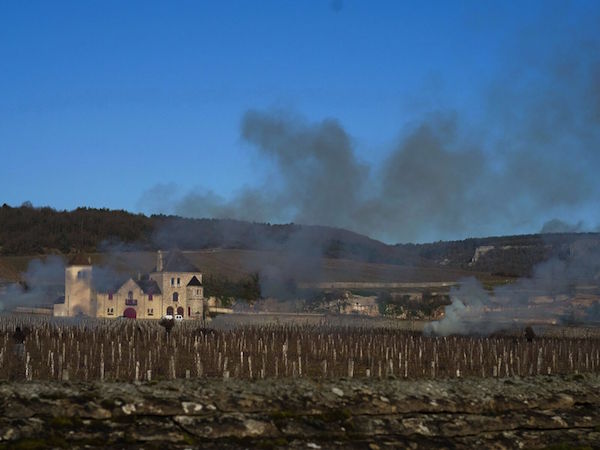
by Wine Owners
Posted on 2016-03-03

OWNER
Domaine Henri Boillot
APPELLATION
Corton-Charlemagne
BLEND
Chardonnay
AVERAGE SCORE
94/100
From the 5th of July, 2014 the value of the wine has steadily appreciated from £808, peaking at £1048 as of 3 March, 2016. (Overall: steady growth)
Yellow: 2008 Green: 2009 Purple: 2010 Blue: 2011
REVIEW
This flight of 2011s comes to a close with the 2011 Corton-Charlemagne, a cool, introspective and powerful wine. Layers of bright citrus, mint and crushed rocks fill out the wine's big, broad-shouldered frame nicely. The intense, tight finish suggests the Corton-Charlemagne is going to require a measure of patience. Based on what I tasted, it's hard to argue that point. Boillot seems to be one case where the 2011s have the potential to be better across the board than the 2010s. (Robert Parker, Aug 2012).
by Wine Owners
Posted on 2014-02-22
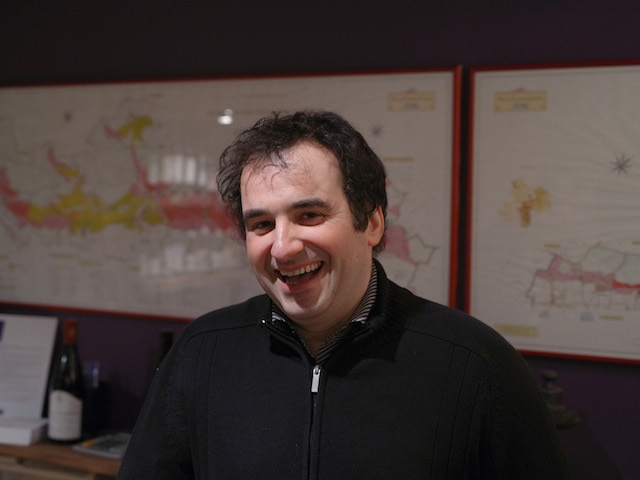
By Jean-Marc Vincent
Following a 2012 vintage of outstanding quality but with quantities commonly down 50%+, growers were hoping for a more bountiful 2013. Sadly it was not to be. Burgundian vignerons have had just cause to complain (regarding yields) since the start of the decade, with yet more reasons in 2013.
Winter had been long, spring was cold and rainy followed by an irregular summer of hot interludes interspersed with colder, wet weather. The harvest could only start at the beginning of October in most of First floors across the Côte d’Or.
A cold and wet spring had led to coulure and millerandage, with hailstorms proliferating the spread of mildew and oidium resulting in much reduced yields at harvest.
From North to South, no region was spared. Really low yields resulted in overall volumes equal to or less than 2012 (1.26 million hl). Fortunately the quality evident at the end of the harvest was good, even if far more heterogeneous than in 2012.
THE SEASONS
Winter started late. From January to March, temperatures stayed cool. The beginning of spring was also very chilly and prevented the vine from starting – causing almost 2 weeks of delay.
In early May, when the first buds finally appeared, heavy rains hit the region in waves. Plots from the lower slopes were totally flooded during the course of a week. Temperatures came close to causing frosts. We came within an inch of disaster repeatedly.
In June, the cold temperatures and rain were incessant, leading to a 3 week-late flowering. Coulure and millerandage reduced the crop significantly, at times by half. The hot, dry and sunny start of summer reassured and benefited the vine. It encouraged a good finish to the plants’ growth phase.
The last fortnight of July suffered from a violent storm in the Côte de Beaune (1,350 ha were hit on the 23rd of July). August was irregular and finally the ripening of the grapes kicked off.
September didn’t spare the the vines either. Mild temperatures and and regular rain led to rot (Botrytis ), which spared the well ventilated bunches of little berries in the case of pinot noir (millerands). The choice of the harvest date was to prove crucial. It was essential to wait for a proper maturity and then pick each plot really quickly.
THE WINES
The vintage was a difficult one and favoured the most serious, meticulous, and cool-headed! Vignerons who worked thoroughly back in May – the moment when those who took the necessary risks of making a small harvest for the 4th year in a row – will release high quality wines.
The low yields explain the quality-to-be of the best cuvées. The whites are taut but not agressive and have an amazing minerality thanks to a chilly month of August which preserved acidity, minerality and their aromatic complexity. The bunches of pinot noir were really millerandées (small berries which tend to proliferate on older vines), extremely wholesome and help explain the unexpected level of quality in such a cold vintage. At the best addresses, the reds are aromatic, showing freshness and length.
In the end, 2013 is promising to be a very classic burgundy vintage that should interest enthusiasts.
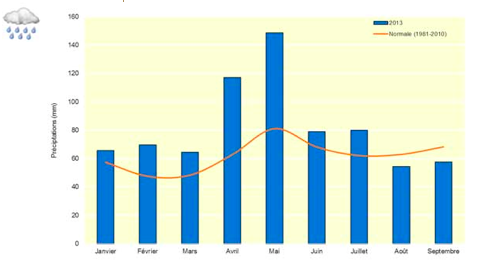
Jean-Marc Vincent is a brilliant, thoughtful, meticulous vigneron based in Santenay, who together with his delightful wife Anne-Marie, are producing fabulously pure wines that age beautifully at their tiny domaine. His 2012s are exceptional.
Original French version:
Après une année 2012 de grande qualité mais qui n’avait donné bien souvent que la moitié d’une récolte normale, les vignerons de Bourgogne espéraient une année 2013 plus généreuse. Et bien non! Les vignerons bourguignons n’ont pas fini de se plaindre du début de cette décennie et particulièrement de 2013.
L’ hiver a été long, le printemps froid et pluvieux suivi d’un été irrégulier ou des périodes de chaleur ont été suivies par un temps plus froid et humide. Les vendanges n’ont pu démarrer que début octobre dans la plupart des vignobles de Côte d’Or.
Un printemps froid et humide a entrainé coulure et millerandage, orages de grêle, attaques de mildiou et d’oïdium, ce qui a fortement réduit les quantités récoltées.
Du nord au sud, aucune région viticole n’a été tout à fait épargnée. De très petits rendements ont donné un volume égal voire inférieur à celui de 2012 (1,26 millions d’hectolitres1). Heureusement, la qualité, quoique plus hétérogène qu’en 2012 est souvent au rendez-vous à l’issue des vendanges.
LES SAISONS
L’hiver a été tardif en Bourgogne. De janvier à mars, les températures restent fraîches. Le début du printemps est lui aussi très frais et empêche la vigne de démarrer, avec au final près de 2 semaines de retard.
Début mai, alors que les premiers bourgeons apparaissent enfin, des pluies importantes tombent fréquemment sur la région. Des parcelles de bas de coteaux sont complètement inondées pendant une semaine. On frise la gelée et la destruction complète de récolte plusieurs fois.
En Juin, le froid et la pluie persistent, entraînant un retard de floraison d’environ 3 semaines. Coulure et millerandage réduisent la récolte considérablement, parfois de moitié. Le début d’été, chaud, sec et ensoleillé rassure et profite à la vigne. Il permet d’obtenir une bonne fin de croissance.
La deuxième quinzaine de Juillet est marquée par un violent orage de grêle sur la Côte de Beaune (1 350 ha touchés le 23 juillet). Août est irrégulier et enfin la maturation des raisins commence.
Septembre ne ménage pas les vignes. La douceur ambiante et les pluies régulières favorisent la pourriture (Botrytis), limitée sur les grappes aérées constituées de petites baies dans le cas du pinot noir. Le choix de la date de récolte est essentiel. Il faut savoir attendre une vraie maturité et ensuite vendanger très rapidement chaque parcelle.
LES VINS
Le millésime a été difficile et va révéler les vignerons les plus sérieux, les plus assidus et avec le plus de sang-froid! Tous les vignerons ayant fait le choix en mai d’un travail soigné et ayant pris le risque de faire pour la quatrième fois de suite une petite récolte vont signer des vins de très bonne qualité.
Le faible rendement va expliquer la qualité des meilleures cuvées. Les blancs sont tendus mais pas agressifs et bénéficient d’une minéralité exceptionnelle du à un mois d’août frais qui a préservé les acidités, les minéraux et même les arômes. Les grappes de pinot noir étaient très millerandées, très saines et expliquent un niveau de qualité inattendu dans un millésime aussi frais. Chez les meilleurs producteurs, les vins rouges sont aromatiques, avec de la fraicheur et de la longueur.
Au final, un millésime bourguignon très classique et recommandé aux vrais amateurs de vins de Bourgogne.
by Wine Owners
Posted on 2012-06-15
Several directors of Labouré-Roi, the Nuits-St.-Georges negociant, have been arrested following a year's investigation by the French Fraud Squad (DGCCRF).
For several years, since 2005 through 2009, Labouré-Roi been accused of consumer fraud; systematically mis-labelling burgundies from village wines through to Grand Crus, blending juice inappropriately, and making false claims about fictitious competition medals.
Labouré-Roi is Burgundy's 3rd largest negociant by volume, and the fraud affects 2,000,000 bottles.
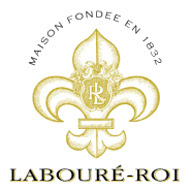
Quatre dirigeants de la maison de négoce en vins de Bourgogne Labouré-Roi, basée à Nuits-Saint-Georges (Côte-d'Or), ont été placés en garde à vue la semaine dernière dans le cadre d'une affaire de fraude sur les vins, a-t-on appris mercredi 13 juin auprès de leur avocat. Il leur est reproché des faits de "tricherie sur les étiquettes", des "mélanges de vins" et l'utilisation de "fausse médailles", selon le quotidien Le Bien Public qui a révélé l'affaire.
Does this spell the end of the Famille Cottin's ownership of the long-standing Maison founded in 1832 and acquired by them in 1974? Le Monde quotes the company's Counsel as fearing the worst if banks refuse borrowings following the scandal that has made headlines in France.
As Burgundy buzzes with interest & growing sales from China, stories of grand-scale fraud are the last thing the BIVB (Bureau Interprofessionel des Vins de Bourgogne) needs after all its excellent work educating Far Eastern buyers on the value ofClassification and micro-climats.

